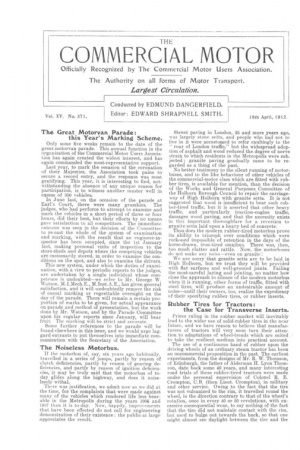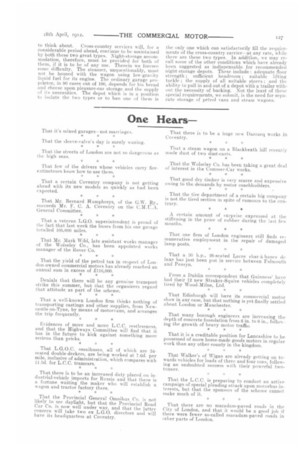The Great Motorvan Parade: this Year's Marking Scheme.
Page 1

Page 2

Page 3

If you've noticed an error in this article please click here to report it so we can fix it.
Only some five weeks remain to the date of the great motorvan parade. This annual function in the organization of the Commercial Motor Users Association has again created the widest interest, and has again commanded the most-representative support.
Last year, to mark the occasion of the coronation of their Majesties, the Association took pains to secure a record entry, and the response was most gratifying. This year, it is interesting to find, notwithstanding the absence of any unique reason for participation, is to witness another muster well in excess of 300 vehicles.
In June last, on the occasion of the parade at Earl's Court, there were many grumbles. The judges, who had perforce to attempt to examine and mark the vehicles in a short period of three or four hours, did their best, but their efforts by no means gave satisfaction to all competitors. The immediate outcome was seen in the decision of the Committee to re-cast the whole of the system of examination and marking, with the result that an engineer-inspector has been occupied, since the 1st January last, making personal visits of inspection to the store-sheds and depots where the competing vehicles are customarily stored, in order to examine the conditions on the spot, and also to examine the drivers. This new system, under which the duties of examination, with a view to periodic reports to the judges, are undertaken by a single individual whose competence is undoubted—we refer to Mr. George W. Watson, M.I.Mech.E., M.Inst.A.E., has given general satisfaction, and it will undoubtedly remove the risk of casual marking or regrettable oversight on the day of the parade. There will remain a certain proportion of marks to be given, for actual appearance on parade and method of presentation, but the work done by Mr. Watson, and by the Parade Committee upon his regular reports since January, will bear fruit. The marking will be strict and accurate.
Some further references to the parade will be found elsewhere in this issue, and we would urge laggard entrants to put themselves into immediate communication with the Secretary of the Association.
The Noiseless Motorbus.
If the motorbus of, say, six years ago habitually, travelled in a series of jumps, partly by reason of clutch deficiencies, partly by reason of gearing deficiencies, and partly by reason of ignition deficiencies, it may be truly said that the motorbus of today glides along the highway, and does it noiselessly withal.
There was justification, we admit now as we did at the time, for the complaints that were made against many of the vehicles which rendered life less bearable in the Metropolis during the years 1908 and 1907 than it is to-day. Now, happily, improvements that have been effected do not call for engineering demonstration of their existence : the public at large appreciates the result. Street paving in London, 25 and more years ago, was largely stone setts, and people who had not to live in it were accustomed to refer exultingly to the
roar of London traffic," but the widespread adoption of asphalt and wood reduced the degree of nerve strain to which residents in the Metropolis were subjected; granite paving gradually came to be regarded as a thing of the past.
No better testimony to the silent running of motorbuses, and to the like behaviour of other vehicles of the commercial-motor class which are fitted with rubber tires, is available for mention, than the decision of the Works and General Purposes Committee of the Holborn Borough Council to repair the carriageway of High Holborn with granite setts. It is not suggested that wood is insufficient to bear such rubber-tired traffic, but. it is asserted that other heavy traffic, and particularly traction-engine traffic, damages wood paving, and that the necessity exists in this important thoroughfare for a reversion to granite setts laid upon a heavy bed of concrete.
Thus does the modern rubber-tired motorbus prove its ability to triumph over conditions which were reckoned impossible of retention in the days of the horse-drawn, iron-tired omnibus. There was, then, too much clatter and rattle. Now, the motorbuses do not make any noise—even on granite : We are sorry that granite setts are to be laid in High Holborn, but we trust they will be provided with flat surfaces and well-grouted joints. Failing the most-careful laying and jointing, no matter how close the approach to silence of the modern motorbus when it is running, other forms of traffic, fitted with steel tires, will produce an undesirable amount of noise—until their owners, too, realize the expediency of their specifying rubber tires, or rubber inserts.
Rubber Tires for Tractors:
the Case for Transverse Inserts.
Prices ruling in the rubber market will inevitably lead to the wider use of solid-rubber tires in the near future, and we have reason to believe that manufacturers of tractors will very soon turn their attention to adaptations of wheel-treads which are suited to take the resilient medium into practical account. The use of a continuous band of rubber upon the driving wheels of an ordinary steam tractor has been an uncommercial proposition in the past. The earliest experiments, from the designs of Mr. R. W. Thomson, of Edinburgh, the father of Alderman H. Lyon Thomson, date back some 40 years, and many interesting road trials of these rubber-tired tractors were made under the personal supervision of Colonel B. E. Crompton, C.B. (then Lieut. (Jrompton), in military and other service. Owing to the fact that the tire was not vulcanized to the rim, it travelled round the wheel, in the direction contrary to that of the wheel's rotation, once in every 40 or 50 revolutions, with excessive consequential wear, to say nothing of the fact that the tire did not maintain contact with the rim, but used to bulge out towards the back, so that one might almost see daylight between the tire and the
rim at times. Those, of course, were very early days. The use of rubber, then, was regarded as a wild experiment. In fact, so recently as the year 1902, when solid-rubber tires were for the first time fitted to a modern commercial vehicle, as part of the service for the parcel mail between Liverpool and Manchester, the departure was still regarded as an experiment, to which belief much support was given by the high disclosed cost of running—in the neighbourhood of 10d. per mile, for tires alone, upon a 30-cwt. van.
There have been many experiments, on the part of tractor manufacturers and owners, to produce a satisfactory resilient tread. Various designs of block and spring treads have been put upon the market, but the demand for something better is insistent and unsatisfied at the moment of writing. Rubber supplies will rapidly multiply, when large additional numbers of the eastern plantations come into bearing, a couple of years hence, and it is unlikely that supply will be insufficient to keep prices down to a normal level, by which we understand something on the low side of 4s. per lb. Economies in connection with the gathering of Brazilian rubber will, probably, in spite of current statements to the contrary, encourage prospectors to send out their expeditions at times when the price is below the supposed minimum of remunerative working, which is stated to be 4s. per lb. Of course, were the Brazilian supplies not to be forthcoming, or to be suspended to any considerable extent, a new factor would be introduced into the situation, and one of effect that it is almost impossible to estimate, in relation to price fluctuations. Here, it must be admitted, one finds an element of uncertainty, no matter how fully production may be developed in the East. It is not to the application of continuous bands of rubber, in circumferential lengths which exceed 17 ft., and in widths which are seldom less than 10 in., that we look. We anticipate slight modifications in the present system of grooving the treadplates of tractor wheels, and this will be done in such a manner that the grooves will be formed as the equivalent of a series of transverse clincher sections, spaced around the tire at uniform distances apart. Inserts of shaped rubber will be pushed into these grooves, and be held in them more firmly than any clinched tire can be held in a clincher-section rim. An ordinary locking ring might then be secured in position, in order to prevent the strips of rubber from working out sideways. Provision against damage by the rolling-out of the plates must be regarded in the design of the sections. Not only wolld an arrangement of the kind undoubtedly be invaluable on ice and snow, but it would greatly reduce vibration and noise on paved surfaces. Again, were the transverse lengths of rubber disposed sufficiently closely to one another, there would virtually be continuous rubber contact with the highway, or with any other surface over which the engine happened to be travelling. It is obvious, too, that some arrangement of the kind might also be applied to the driving wheels of steam wagons, and it will probably occur to some readers that the use of short lengths of rubber, disposed across the tires, may open the door for the ultimate use of many tire sections which are now merely sold to dealers as waste rubber. At the same time, we should prefer to see new lengths, cut for the job, employed.
Mixed Garages.
Now that night-storage accommodation during cross-country trips is becoming a matter of actual urgency, it behoves us all closely to examine the possibilities of the establishment of new depots and the approval of old ones from all possible standpoints. The C.M.U.A., it will be remembered, has the matter well in hand, but its committee will, we feel sure, be glad of practical suggestions from all competent quarters. It is a debatable point as to whether steam or petrol wagons were most used for long-distance jobs during recent periods of railway shortcomings. That either type is nowadays well able to do much of the railways' work could not have been better exemplified than by the conditions for which the late labour crises have been responsible Economically, however, it has not been settled whether internal or external combustion has performed conclusively-superior service. " Steam v. petrol" is to be a subject of keen controversy in the near future. The rubbertired steamer has given the petrol-wagon something
to think about. Cross-country services will, for a
considerable period ahead, continue to be maintained by both these two great types. Night-storage accommodation, therefore, must be provided for both of them, if it is to be of any use. Therein we foresee some difficulty. The steamer, unquestionably, must. not be housed with the wagon using low-gravity liquid fuel for its engine. The ordinary garage proprietor, in 90 cases out of 100, depends for his bread and cheese upon pleasure-car storage and the supply of its necessities. The depot which is in a position to isolate the two types or to ban one of them is the only one which can satisfactorily fill the requirements of the cross-country carrier—at any rate, while there are these two types. In addition, we may recall some of the other conditions which have already been suggested as indispensable for recommended night-storage depots. These include : adequate floor strength ; sufficient headroom ; suitable lifting tackle ; the supply of all suitable stores ; and the ability to pull in and out of a depot with a trailer without the necessity of backing. Not the least of these special requirements, we submit, is the need for separate storage of petrol vans and steam wagons.






















